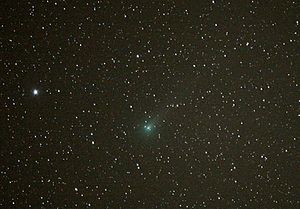C / 2007 E2 (Lovejoy)
| C / 2007 E2 (Lovejoy) [i] | |
|---|---|

|
|
| C / 2007 E2 (Lovejoy) on May 9, 2007 | |
| Properties of the orbit ( animation ) | |
| Orbit type | long-period |
| Numerical eccentricity | 0.99918 |
| Perihelion | 1.093 AU |
| Aphelion | 2666 AE |
| Major semi-axis | 1333 AU |
| Sidereal period | ~ 48,700 |
| Inclination of the orbit plane | 95.9 ° |
| Perihelion | March 27, 2007 |
| Orbital velocity in the perihelion | 40.3 km / s |
| history | |
| Explorer | Terry Lovejoy |
| Date of discovery | March 15, 2007 |
| Source: Unless otherwise stated, the data comes from JPL Small-Body Database Browser . Please also note the note on comet articles . | |
C / 2007 E2 (Lovejoy) is a comet that could be observed with binoculars in 2007 . It is the first comet to be discovered with a digital camera without the use of a telescope .
Discovery and observation
The Australian amateur astronomer T. Lovejoy had sporadically searched for comets in Queensland as early as the 1980s and 1990s. He seriously began the comet search in 2004 by taking numerous pictures of the same areas of the sky at short intervals and comparing them with a blinking comparator . In the period from March 15 to 17, 2007, he again took several pictures with his digital camera, which was equipped with a 200 mm f / 2.8 lens . Then he discovered his first comet. Telescopic images from various observers on the following days were able to confirm the discovery. The brightness was already about 10 mag and the comet was only about 1.1 AU away from the sun and earth at that time . Shortly thereafter, Brian Marsden was able to perform a preliminary orbit calculation.
From mid-March the comet could also be found in the northern hemisphere at dawn . Its brightness was around 7–8 mag. It moved quickly north and from mid-May could be seen all night, while its brightness was already decreasing again. The comet could be observed telescopically until the end of August.
Orbit
For the comet, an elliptical orbit could be determined from 1656 observation data over a period of 158 days , which is inclined by around 96 ° to the ecliptic . The comet's orbit is thus almost perpendicular to the orbits of the planets and its orbit runs in the opposite direction ( retrograde ) to them. At the point closest to the Sun ( perihelion ), which the comet passed on March 27, 2007, it was still about 163.5 million km from the Sun and was thus a little further away from it than the Earth. On April 25, it approached this to about 66.2 million km (0.44 AU). There were no noteworthy approaches to the other small planets.
In the vicinity of the ascending node of its orbit, the comet even approached the earth's orbit to almost 17 million km (0.11 AU) around April 13, 2007, but the earth only reached this point in its orbit about one month later on May 14th.
According to the orbital elements, which are afflicted with a certain uncertainty, as they are specified in the JPL Small-Body Database and which do not take into account non-gravitational forces on the comet, the comet was still moving on an extremely elongated elliptical orbit long before its passage through the inner solar system with an eccentricity of around 0.99882 and a semi-major axis of around 925 AU, so that its period of revolution was around 28,000 years. Due to the gravitational pull of the planets, especially due to the relatively close passages of Saturn on May 22nd, 2005 at a distance of about 8 ¼ AU, at Jupiter on April 20, 2007 in about 4 ¼ AU distance, and one more time at Saturn on June 24th In 2007 at a distance of about 9 ¼ AU, its orbital eccentricity was reduced to about 0.99860 and its semi-major axis to about 780 AU, so that its orbital period is shortened to about 22,000 years.
See also
Web links
- C / 2007 E2 (Lovejoy) Seiichi Yoshida's Home Page (English)
Individual evidence
- ^ E. Howell: Comet Lovejoy: The Sungrazer That Survived. In: Space.com. Future US, Inc., May 1, 2014, accessed August 9, 2020 .
- ^ J. Rao: New Green Comet Set for April Show. In: Space.com. Future US, Inc., March 30, 2007, accessed August 9, 2020 .
- ↑ B. Marsden: MPEC 2007 F32: COMET C / 2007 E2 (Lovejoy). In: Minor Planet Electronic Circular. IAU, March 19, 2007, accessed August 9, 2020 .
- ^ Comet Lovejoy (C / 2007 E2). In: Kometen.info. April 22, 2007, accessed August 9, 2020 .
- ↑ C / 2007 E2 (Lovejoy) in the Small-Body Database of the Jet Propulsion Laboratory (English).
- ↑ A. Vitagliano: SOLEX 12.1. Retrieved July 9, 2020 .